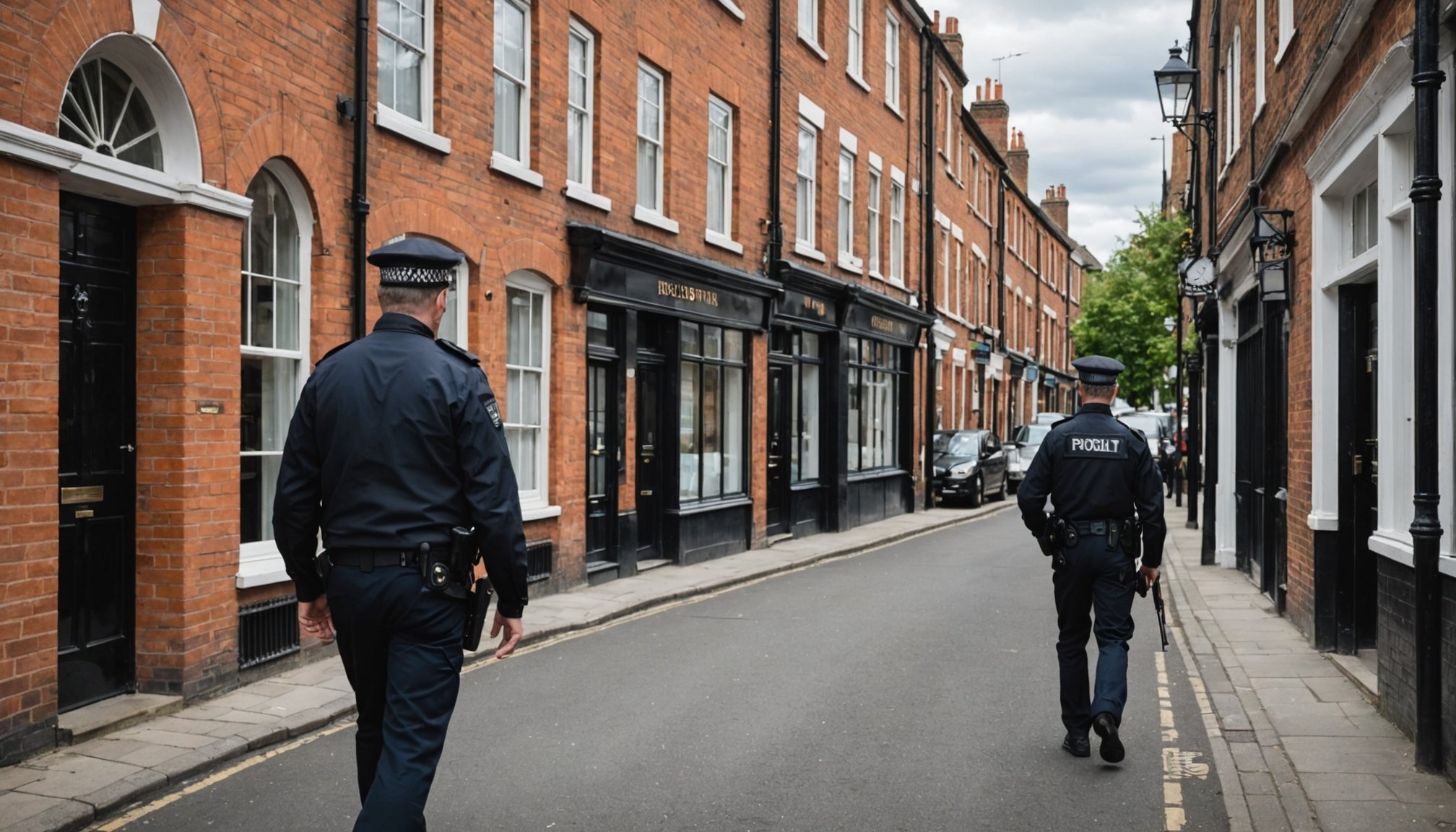Overview of Crime Rates in London
Understanding crime statistics in London offers insight into community safety perceptions. Recent data suggests a notable incidence of burglary and theft, affecting various neighbourhoods. The identification of high-crime areas helps in pointing out where these offences are most prevalent.
In some regions of London, the crime rate is particularly high due to increased instances of theft and burglary. This is often linked to socio-economic factors, population density, and the availability of targets. High-crime areas necessitate a focus not only on individual safety but also on broader community security measures.
Also read : Key Considerations for Your Property Survey When Purchasing Near the River Thames
Crime rates significantly impact how safe people feel in their communities. In locales with elevated crime statistics, residents often report a sense of insecurity, which can affect their overall quality of life. Fear of crime can lead to reduced social interactions and a hesitant engagement with community activities, further perpetuating a cycle of unease.
By analyzing recent crime statistics, stakeholders can identify patterns and potential solutions tailored to address the issues faced by high-crime areas. This involves deploying targeted law enforcement strategies and enhancing community programs designed to reduce crime and improve perceptions of safety among residents.
Have you seen this : Key Guidelines for Transforming a Barn into a Cozy Home in Rural Wales
Importance of Home Security
Living in a high-crime area can pose several risks, making home security a critical concern. These areas often see increased burglary and theft rates, necessitating homeowners to take proactive measures for their personal safety and property protection. Understanding these risks is essential for safeguarding one’s household.
Installing effective home security systems not only protects physical assets but also offers significant psychological benefits. Homeowners often experience reduced anxiety and a greater sense of personal security, knowing preventative measures are in place to deter potential offenders. The assurance that comes with improved security can significantly enhance overall well-being, allowing residents to feel more comfortable within their homes.
Moreover, crime can have far-reaching economic implications for homeowners. High crime rates can reduce property values, increase insurance premiums, and result in costly damages if properties are targeted. By investing in robust home security solutions, homeowners can mitigate financial losses and potentially raise the property’s market appeal.
Implementing security strategies demonstrates a practical approach to addressing the challenges associated with living in high-crime areas. By understanding the importance of safeguarding one’s home, individuals can create a more secure and peaceful living environment. Taking action towards property protection not only benefits the individual homeowner but also strengthens community resilience against crime.
Effective Home Security Strategies
Developing a robust home defense strategy is crucial for deterring potential criminals and ensuring peace of mind. Various security measures can fortify your home, creating a safer environment.
Neighbourhood Watch Programs
Engaging in community-driven initiatives like Neighbourhood Watch Programs can play a vital role in crime prevention. These programs enhance collective vigilance and foster a sense of camaraderie, ultimately leading to safer neighbourhoods. Many localities report crime reduction by actively participating in such frameworks, highlighting the power of united community efforts.
Home Alarm Systems
Selecting appropriate home alarm systems is essential. Various systems range from basic alarms to comprehensive setups with advanced features like motion detectors. When choosing an alarm system, consider factors like coverage needs and budget constraints to make an informed choice.
Surveillance Options
Surveillance measures provide a powerful deterrent against crime. Residential areas can benefit from installing a range of cameras, from discreet models to more visible deterrents. These tools not only capture evidence in case of incidents but also serve as a constant reminder of the monitored environment, discouraging potential intruders.
Reinforcing Doors and Windows
Strengthening entry points is a pivotal preventive tactic. Utilizing solid materials and reinforced frames can significantly enhance your home’s security. Prioritizing these measures ensures that your dwelling remains a less appealing target for opportunistic burglars.
Utilizing Technology for Security
Embracing smart home technology can transform your approach to security, offering advanced digital security solutions. A key advantage lies in the integration of home automation systems, which not only enhance security but also contribute to a more connected living environment.
Smart security devices, such as automated locks, surveillance cameras, and motion detectors, provide real-time alerts and monitoring. This allows homeowners to keep a vigilant watch over their property, even remotely. Integration with home automation means these devices can communicate seamlessly, creating a comprehensive security network that adjusts to activity patterns and improves overall safety.
With the rise of smart home technology, future trends are likely to focus on even more sophisticated solutions. For instance, the evolution of artificial intelligence may facilitate predictive security systems that anticipate threats before they occur. Voice-activated controls and biometric access are also gaining traction, offering both convenience and enhanced protection.
Investing in digital security and home automation not only secures your property but can also simplify everyday living. As technology advances, staying informed about emerging trends ensures you make the best choices for creating a secure, modern home environment.
Community Resources and Support
Navigating the landscape of local resources can significantly bolster community safety, offering residents accessible avenues for support. Tapping into local police resources is foundational, as their presence provides a layer of reassurance and rapid response capability. Police-led initiatives, such as regular patrols and public safety workshops, aim to bridge the gap between law enforcement and community members.
Engagement in community safety efforts plays a critical role in neighbourhood security. By fostering a strong sense of collaboration, residents can collectively address safety concerns and develop targeted strategies for crime prevention. Simple acts such as attending local safety meetings or participating in community events help to fortify ties, ensuring a cohesive response to crime-related challenges.
Emergency services form another vital pillar of community support. Awareness of these services, alongside understanding response protocols, empowers residents to act confidently in emergencies. Knowledge of hotlines for crime reporting and support networks enhances individual and collective preparedness.
Local councils often spearhead programs focused on resident safety, implementing educational campaigns and infrastructure improvements. Their input is invaluable in tackling area-specific issues, crafting tailored solutions that reflect the community’s unique needs. The combination of resident involvement and institutional support creates a robust, layered approach to enhancing safety and well-being.
Real-Life Case Studies
Crime prevention success stories highlight meaningful change within communities through effective security examples. One case study in London emphasized the transformative power of community-led security initiatives. Neighbourhoods plagued by high burglary rates collaborated with local councils to implement tailored security measures. These included motion-sensor lighting and community patrols.
Resultantly, these areas saw a significant drop in crime rates. A key lesson from such successes is the need for proactive resident involvement. It fostered a joint responsibility, promoting safer environments and increasing neighbourly bonds.
Statistics further underline these benefits: after instituting these measures, residential thefts reportedly decreased by 40%. Residents noted a heightened sense of safety, showcasing the tangible effects of cohesive intervention. Beyond individual homes, crime prevention success stories benefited entire communities, reinforcing the importance of shared responsibility.
Another London-based initiative transformed a notoriously high-crime area by employing a comprehensive security strategy. This included an advanced surveillance system paired with community watch efforts. Crime rates plummeted as collective vigilance discouraged potential offenders.
These effective security examples illustrate how strategic cooperation and technology-enhanced vigilance can dramatically improve community safety. Following these models, other high-crime neighbourhoods can tailor similar measures to their specific needs, nurturing safer, cohesive environments over time.











